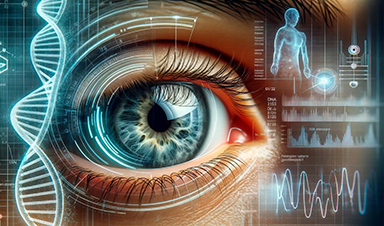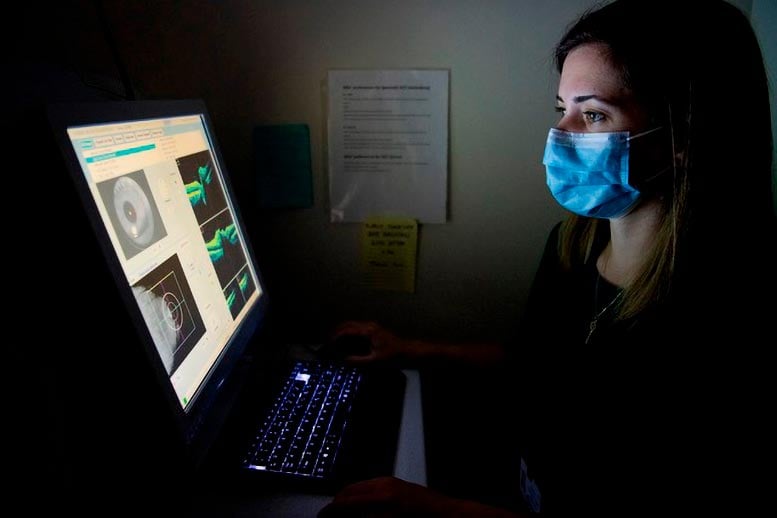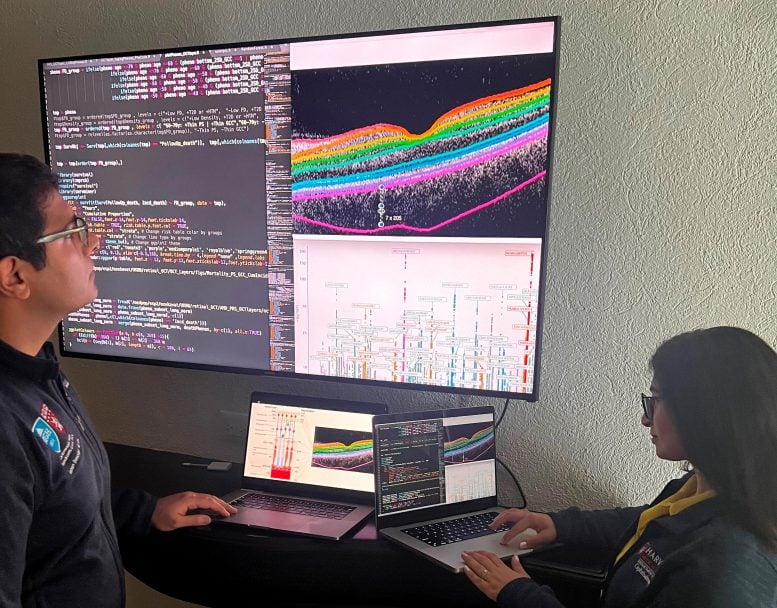- Mass Eye and Ear physician-researchers show that retinal imaging can help predict a person’s risk of developing ocular, neuropsychiatric, cardiac, metabolic, and pulmonary diseases.
- The team also identified genetic loci associated with retinal thinning, which could help develop personalized treatment plans and future therapies for eye diseases such as glaucoma and macular degeneration.
The retina is said to provide a window into a person’s systemic health. In a new study published on January 24th in Science Translational Medicine, physician-researchers from Mass Eye and Ear, a member of Mass General Brigham, and the Broad Institute of MIT and Harvard combined retinal imaging, genetics, and big data to estimate how likely a person is to develop eye and systemic diseases in the future. They found significant associations between the thinning of different retinal layers and increased risk of developing ocular, neuropsychiatric, cardiac, metabolic, and pulmonary diseases and identified genes that are associated with retinal layer thickness.
Predictive Power of Retinal Images
“We showed that retinal images could be used to predict the future risk of both ocular disease and systemic disease,” says first author Seyedeh Maryam Zekavat, MD, PhD, a Harvard Ophthalmology resident at Mass Eye and Ear and graduate student at Broad. “This could potentially help with disease prevention—if we know from someone’s retinal image that they are at high risk of developing glaucoma or cardiovascular disease in the future, we could refer them for follow-up screening or preventative treatment.”
Because of its position behind the transparent structures of the eye, the retina is easy to visualize and image non-invasively, and retinal imaging is already a routine procedure in ophthalmology. The new study uncovers possibilities for preventative medicine and crosstalk between ophthalmologists and other areas of medicine.
Senior study author Nazlee Zebardast, MD, MSc, director of Glaucoma Imaging at Mass Eye and Ear, examines OCT images. Credit: Mass Eye and Ear
Linking Retinal Health With Systemic Conditions
Previous studies have shown that there are links between retinal health and health conditions including aging, cardiometabolic diseases such as diabetes and hypertension, and neurological diseases such as dementia, stroke, and multiple sclerosis.
“We’ve come to realize recently that there is a lot more information that we can get from our retina images than we thought was possible,” says senior author Nazlee Zebardast, MD, MSc, director of Glaucoma Imaging at Mass Eye and Ear and an assistant professor of ophthalmology at Harvard Medical School. “It’s really exciting to be able to see that these images, which are obtained without having to do any sort of invasive procedure, are associated with so many systemic conditions, both at a genetic level as well as an epidemiologic level.”
To identify associations between retinal health and disease risk, and to identify genes associated with retinal health, the researchers analyzed data from 44,823 UK Biobank participants who underwent optical coherence tomography (OCT) imaging of the retina, genotyping, and baseline measurements of health in 2010 and were then followed for disease development for an average of ten years.
Study co-first authors Drs. Seyedeh Maryam Zekavat and Saman Doroodgar Jorshery examine data and retinal thickness images. Credit: Mass Eye and Ear
Insights Into Retinal Layers and Genetic Associations
Unlike previous studies that searched for genes associated with overall retina health, this study delved deeper into the role of the different cell layers that make up the retina.
“Each layer of the retina is made up of different types of cells with diverse structures and functions, and we show that the thicknesses of these different layers are associated with different conditions,” says Zebardast, who is also an associated scientist at Broad.
The study also provides insight into the genes and biological pathways that determine retinal health, which could be leveraged to develop future therapies, the researchers say. Altogether, the team identified 259 genetic loci that were associated with retinal thickness.
One particular insight from this work was that multiple systemic health conditions including poor cardiac, metabolic, pulmonary, and renal function are linked to thinning of the photoreceptor segment of the retina, though further research would be needed to confirm causality. Future studies should also aim to replicate the study’s methods in more diverse populations and different age groups, since participants in the UK BioBank were predominantly white and aged 40-70 years old at baseline.
Expanding Clinical Applications and Future Directions
The study is part of an ongoing effort at Mass Eye and Ear to identify genetic markers of glaucoma and other ocular diseases that might help to develop personalized risk scores and treatment plans for patients. Retinal OCT imaging is already a standard clinical procedure in ophthalmology at Mass Eye and Ear and elsewhere, but the authors say that their results suggest that its use could be widened. Further work on the connection between ocular and cardiometabolic health will enable understanding of its clinical utility, and the researchers are extending this line of research along with co-author Pradeep Natarajan, MD, director of preventive cardiology at Massachusetts General Hospital, and an associate member in the Cardiovascular Disease Initiative at Broad.
Conclusion: The Potential of Retinal Imaging in Health Prediction
“Patients come to us for their eye health, but what if we could tell them more than that?” says Zebardast. “What if we could use someone’s retinal images to tell them, ‘You seem to have a high risk of having high blood pressure, maybe you should get screened, or maybe your primary care doctor should know about that.’”
The authors have developed an online user-interface for all of their findings on the Ocular Knowledge Portal, to enable researchers to explore associations between retinal layer thickness, disease, and genetics.
Reference: “Phenome- and genome-wide analyses of retinal optical coherence tomography images identify links between ocular and systemic health” by Seyedeh Maryam Zekavat, Saman Doroodgar Jorshery, Franziska G. Rauscher, Katrin Horn, Sayuri Sekimitsu, Satoshi Koyama, Trang T. Nguyen, Maria C. Costanzo, Dongkeun Jang, Noël P. Burtt, Andreas Kühnapfel, Yusrah Shweikh, Yixuan Ye, Vineet Raghu, Hongyu Zhao, Marzyeh Ghassemi, Tobias Elze, Ayellet V. Segrè, Janey L. Wiggs, Lucian Del Priore, Markus Scholz, Jay C. Wang, Pradeep Natarajan and Nazlee Zebardast, 24 January 2024, Science Translational Medicine.
DOI: 10.1126/scitranslmed.adg4517
Authorship: Seyedeh Maryam Zekavat (MEE, MGH, Broad) Saman Doroodgar Jorshery (Broad) Franziska G. Rauscher (Lepzig), Katrin Horn (Leipzig), Sayuri Sekimitsu (Tufts) Satoshi Koyama (MGH, Broad) Trang T. Nguyen (Broad) Maria C. Costanzo (Broad), Dongkeun Jang (Broad), Noël P. Burtt (Broad), Andreas Kühnapfel (Leipzig) Yusrah Shweikh (MEE), Yixuan Ye (Yale), Vineet Raghu (MGH, Broad), Hongyu Zhao (Yale), Marzyeh Ghassemi (Toronto), Tobias Elze (MEE), Ayellet V. Segrè (MEE) , Janey L. Wiggs (MEE), Lucian Del Priore (Yale), Markus Scholz (Leipzig), Jay C. Wang (Yale) Pradeep Natarajan (MGH, Broad) Nazlee Zebardast (MEE, Broad).
News
Studies detail high rates of long COVID among healthcare, dental workers
Researchers have estimated approximately 8% of Americas have ever experienced long COVID, or lasting symptoms, following an acute COVID-19 infection. Now two recent international studies suggest that the percentage is much higher among healthcare workers [...]
Melting Arctic Ice May Unleash Ancient Deadly Diseases, Scientists Warn
Melting Arctic ice increases human and animal interactions, raising the risk of infectious disease spread. Researchers urge early intervention and surveillance. Climate change is opening new pathways for the spread of infectious diseases such [...]
Scientists May Have Found a Secret Weapon To Stop Pancreatic Cancer Before It Starts
Researchers at Cold Spring Harbor Laboratory have found that blocking the FGFR2 and EGFR genes can stop early-stage pancreatic cancer from progressing, offering a promising path toward prevention. Pancreatic cancer is expected to become [...]
Breakthrough Drug Restores Vision: Researchers Successfully Reverse Retinal Damage
Blocking the PROX1 protein allowed KAIST researchers to regenerate damaged retinas and restore vision in mice. Vision is one of the most important human senses, yet more than 300 million people around the world are at [...]
Differentiating cancerous and healthy cells through motion analysis
Researchers from Tokyo Metropolitan University have found that the motion of unlabeled cells can be used to tell whether they are cancerous or healthy. They observed malignant fibrosarcoma cells and [...]
This Tiny Cellular Gate Could Be the Key to Curing Cancer – And Regrowing Hair
After more than five decades of mystery, scientists have finally unveiled the detailed structure and function of a long-theorized molecular machine in our mitochondria — the mitochondrial pyruvate carrier. This microscopic gatekeeper controls how [...]
Unlocking Vision’s Secrets: Researchers Reveal 3D Structure of Key Eye Protein
Researchers have uncovered the 3D structure of RBP3, a key protein in vision, revealing how it transports retinoids and fatty acids and how its dysfunction may lead to retinal diseases. Proteins play a critical [...]
5 Key Facts About Nanoplastics and How They Affect the Human Body
Nanoplastics are typically defined as plastic particles smaller than 1000 nanometers. These particles are increasingly being detected in human tissues: they can bypass biological barriers, accumulate in organs, and may influence health in ways [...]
Measles Is Back: Doctors Warn of Dangerous Surge Across the U.S.
Parents are encouraged to contact their pediatrician if their child has been exposed to measles or is showing symptoms. Pediatric infectious disease experts are emphasizing the critical importance of measles vaccination, as the highly [...]
AI at the Speed of Light: How Silicon Photonics Are Reinventing Hardware
A cutting-edge AI acceleration platform powered by light rather than electricity could revolutionize how AI is trained and deployed. Using photonic integrated circuits made from advanced III-V semiconductors, researchers have developed a system that vastly [...]
A Grain of Brain, 523 Million Synapses, Most Complicated Neuroscience Experiment Ever Attempted
A team of over 150 scientists has achieved what once seemed impossible: a complete wiring and activity map of a tiny section of a mammalian brain. This feat, part of the MICrONS Project, rivals [...]
The Secret “Radar” Bacteria Use To Outsmart Their Enemies
A chemical radar allows bacteria to sense and eliminate predators. Investigating how microorganisms communicate deepens our understanding of the complex ecological interactions that shape our environment is an area of key focus for the [...]
Psychologists explore ethical issues associated with human-AI relationships
It's becoming increasingly commonplace for people to develop intimate, long-term relationships with artificial intelligence (AI) technologies. At their extreme, people have "married" their AI companions in non-legally binding ceremonies, and at least two people [...]
When You Lose Weight, Where Does It Actually Go?
Most health professionals lack a clear understanding of how body fat is lost, often subscribing to misconceptions like fat converting to energy or muscle. The truth is, fat is actually broken down into carbon [...]
How Everyday Plastics Quietly Turn Into DNA-Damaging Nanoparticles
The same unique structure that makes plastic so versatile also makes it susceptible to breaking down into harmful micro- and nanoscale particles. The world is saturated with trillions of microscopic and nanoscopic plastic particles, some smaller [...]
AI Outperforms Physicians in Real-World Urgent Care Decisions, Study Finds
The study, conducted at the virtual urgent care clinic Cedars-Sinai Connect in LA, compared recommendations given in about 500 visits of adult patients with relatively common symptoms – respiratory, urinary, eye, vaginal and dental. [...]























